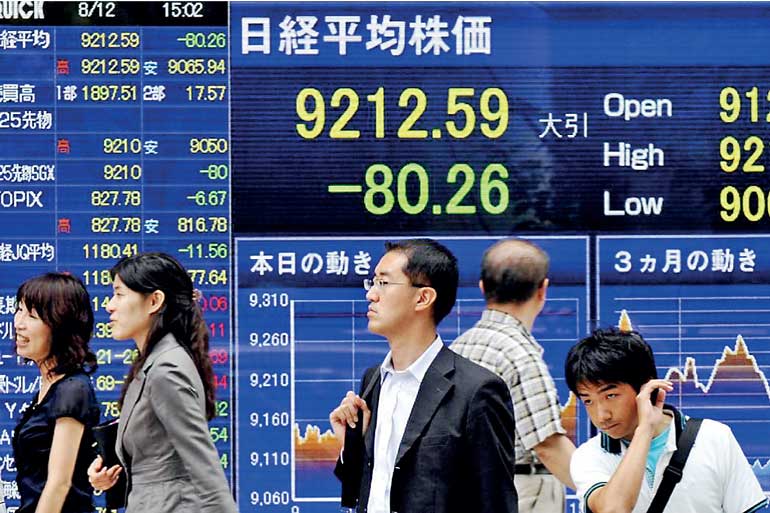Tuesday Nov 18, 2025
Tuesday Nov 18, 2025
Friday, 28 April 2017 00:00 - - {{hitsCtrl.values.hits}}
 REUTERS: Asian shares eased from a near two-year high on Thursday as a long-awaited US tax cut plan failed to inspire investors, though sentiment remained supported by global growth prospects and receding worries about political risks in Europe.
REUTERS: Asian shares eased from a near two-year high on Thursday as a long-awaited US tax cut plan failed to inspire investors, though sentiment remained supported by global growth prospects and receding worries about political risks in Europe.
European shares are expected to slip, with spread-betters looking to a fall of up to 0.5% in Britain’s FTSE, 0.4% in France’s CAC and 0.3% in Germany’s DAX.
MSCI’s broadest index of Asia-Pacific shares outside Japan were almost flat after falling 0.4% earlier in the day. It hit its highest level since June 2015 on Wednesday. Japan’s Nikkei dipped 0.1%.
US President Donald Trump proposed slashing tax rates for businesses to 15% from the current 35% for public corporations and 39.6% for small businesses, and on overseas corporate profits returned to the country.
But the one-page plan, billed as the biggest tax cut in history by the administration, offered no specifics on how it would be paid for without increasing the deficit, which many analysts think would be difficult to achieve.
“There was virtually no new information, just as expected. He was essentially repeating his campaign promises,” said Tomoaki Shishido, senior fixed income strategist at Nomura Securities.
On Wall Street, the S&P 500 ended down 0.05%, failing to cling to earlier gains made on optimistic views on corporate earnings.
Overall profits of S&P 500 companies are estimated to have risen 11.8% in the first quarter, the most since 2011, according to Thomson Reuters I/B/E/S.
The world’s share markets have been bolstered by relief over the first round of the French presidential election and also by signs of solid global economic growth in recent months.
Asian shares have been helped by an upturn in global trade but the US economy is a big wild card going forward because of the uncertainty on its fiscal and trade policies, said Alex Wolf, senior emerging market economist at Standard Life Investments in Hong Kong.
“Chinese demand will slow but not fall off a cliff. European demand is improving and the US is quite strong but it’s not clear how much longer that has to run,” Wolf said, noting the US is further along in its expansion cycle.
The US Congress inched toward a deal to fund the government through September but was preparing to possibly extend a midnight Friday deadline in order to wrap up negotiations and avoid an imminent government shutdown.
Analysts noted, however, that any breakdown in talks and a subsequent government shutdown could raise fresh worries about Trump’s ability to push his agenda down the road.
The disappointment on the tax plan prompted falls in US bond yields and the US dollar.
The 10-year US Treasuries yield slipped to 2.314% from two-week high of 2.350% touched earlier on Wednesday.
The euro traded at $ 1.0903, having bounced back from Wednesday’s low of $ 1.0856 and near its 4-1/2-month high of $ 1.09515 touched on Wednesday.
While no changes are expected, policymakers see scope for sending a small signal in June towards reducing monetary stimulus, according to sources, another factor underpinning the single currency.
The dollar slipped to 111.23 yen from near a one-month high of 111.78 yen scored earlier on Wednesday.
The yen showed no reaction after the Bank of Japan kept its policy unchanged, as expected, with traders looking for more clues from Governor Haruhiko Kuroda’s news conference later in the day (0630 GMT).
The Canadian dollar and the Mexican peso recovered from losses after Trump said he agreed not to terminate the North American Free Trade Agreement (NAFTA).
Earlier the two currencies were battered as the administration was readying an executive order to withdraw from the trade pact.
The Canadian dollar rose 0.5% to C$ 1.3555 per US dollar after having hit a 14-month low of C$ 1.3648 touched earlier in the day.
Similarly, the Mexican peso jumped 1.0% to 19.000 peso to the dollar, off a six-week low of 19.299 peso per dollar on Wednesday.
REUTERS: Oil prices dipped on Thursday, weighed down by a general sentiment of globally bloated markets, though traders said that prices seemed to have found support around current levels.
US West Texas Intermediate (WTI) crude oil futures were trading at $ 49.37 per barrel at 0644 GMT, down 25 cents, or 0.5% from their last close. WTI has lost around 8.5% in value from its April peak.
Brent crude futures, the international benchmark for oil prices, were at $ 51.63 per barrel, down 19 cents, or 0.37%. Brent is almost 9% below its April peak.
Traders said the falls in recent weeks were due to a realisation that global oil markets remained oversupplied, despite efforts led by the Organization of the Petroleum Exporting Countries (OPEC) and Russia to cut output by 1.8 million barrels per day (bpd) during the first half of the year to tighten the market and prop up prices.
“It is clear that the world has plenty of oil in stock, making OPEC’s life that much harder ahead of its June production cut rollover date,” said Jeffrey Halley, senior market analyst at futures brokerage OANDA in Singapore.
While the United States reported a drop in its commercial crude oil stocks on Wednesday, albeit from near-record highs, its gasoline inventories surged as refiners produced more fuel than the market could consume.
Meanwhile, US crude oil production continued its relentless rise, and is now up 10% since mid-2016 at 9.27 million bpd, at comparable levels to the peak oil glut between late 2014 and early 2016.
